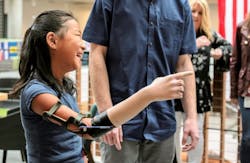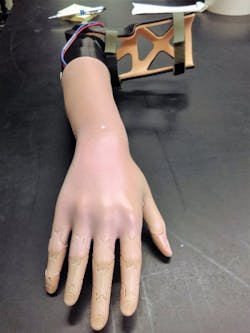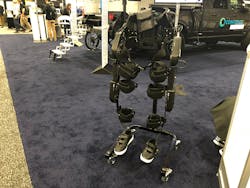Hope Turns into Reality with Robotic Prosthetics, Exoskeletons
Solidworks World 2018 is a celebration of all things design. The show is a massive gathering of designers and engineers who use Solidworks to bring their ideas from the design board to life. If Solidworks wants to make one message clear, it’s that they are enabling the fabrication of the future. Two prime examples that showcase this idea are the amazing creations from Unlimited Tomorrow and SG Robotics.
Unlimited Tomorrow’s 3D-Printed Prosthetics
Easton LaChappelle founded Unlimited Tomorrow in 2014 when he was 18 years old to help assist people in their everyday lives with realistic 3D-printed robotic arms. LaChappelle has been working with robotics since he was 14, starting with a LEGO-inspired robotic hand, and that’s led him to design mind-controlled prosthetics that are affordable for all.
Momo is patient zero for Unlimited Tomorrow. She is the first out of thousands in the future to receive the cutting-edge prosthetic device.
Advanced prosthetics are essential to people recovering from lost limbs and limited mobility. Robotic prosthetics not only replace the lost limbs, giving functionality back to the patient, but also mentally help the patient feel complete. The main problem with these prosthetics is the high cost, which may not be covered by insurance. This is where Unlimited Tomorrow steps in.
Unlimited Tomorrow has created a low-cost process of creating prosthetic arms for individuals. The process starts by sending a scanner attachment that can be connected to a smart device. The patient scans both arms—the missing limb and the still-intact arm—to be used later as reference for the 3D-printing process. This ensures that the 3D-printed arm is as close to being human-like as possible and unique to the patient. The printing and fabrication process takes one to two weeks.
Unlimited aims to match the patient’s skin tone and provide realistic-like features such as paintable fingernails. The average arm weighs around one pound, and with regular use, the battery life is three to four days. The arm has advanced sensing and learning features. Haptics is incorporated into the arm to provide force feedback to the patient. It’s muscle-operated, and is equipped with machine learning for advanced control.
Stratasys has partnered with Unlimited Tomorrow to keep the production costs as low as possible, even 3D printing the first 100 prosthetic arms at no cost.
According to LaChapelle, the mission of Unlimited Tomorrow “is to empower amputees by an intuitive scalable model to create custom devices from start to finish. We are using the newest technologies such as 3D scans, 3D printing, and machine learning to make the next generation of artificial limbs at the lowest cost possible.”
At the show, Stratasys announced a new partnership with Unlimited Tomorrow to become its sole 3D-printing partner. The company will produce the first 100 robotic arms for free and help create a streamlined process to ensure the continued low cost of these prostheses. Traditional prosthetic models are often heavy, cumbersome, and expensive—they cost recipients a minimum of $20,000 per device, to upwards of $100,000. Unlimited Tomorrow offers its prosthetics at $5,000 per arm, and looks to continue lowering the cost to aid everyone that needs a prosthetic limb.
The project, www.TheRoboArm.com, is open-source and accessible to all.
SG Robotics
SG Robotics is the brain-child of controls engineer Kychongul Kong. As a professor, he observed one of his fellow lab partners who was paralyzed from the waist down and felt inspired to design a robotic exoskeleton to help him walk again.
Founder of SG Robotics Kyoungchul Kong, on stage at Solidworks World 2018 with Marie Planchard, Director of Education and Early Engagement at Solidworks, unveil the WalkON and Angelegs exoskeleton suits to the crowd.
In 2014, Kong founded SG Mechatronics, which in 2017 became SG Robotics, a South Korean-based robotics exoskeleton company. Kong’s first design, the WalkON Suit, went through several iterations, including motion detection and automatic movement features. However, after testing the suit, the patient felt most comfortable using manual controls to drive the suit. The legs are powered via Maxon Motor’s EC22. There are four redundant motors to ensure constant travel. It has a driving force of 250 Nm and a maximum speed of 45 revolutions per minute.
The highly efficient suit mimics human muscle structure. The design is based on knee, ankle, and foot orthotics to tightly fit the wearer’s body. A pneumatic actuator in the suit acts like a spring in the standing position. The actuator is not connected to any power pneumatic pump, and when the legs are in the swing position or moving, the actuator provides no resistance.
This design feature won Kong a best patent award in South Korea last year. The total weight of the suit is 28 kilograms, and not only does it walk, but also sits, stands, and navigates stairs. Within two years, the WalkON suit competed in the Power Exoskeleon Race of Cybatholon in 2016 and won a medal.
The WalkON exoskeleton robotics suit will help those completely paralyzed from the waist down to not only walk again, but also have complete control of their legs, with the ability to stand up and climb stairs.
The next iteration of the suit was the Angelegs, a lighter-weight design for those needing robotic mechanical assistance. The Angelegs have a zero impedance actuator with precise force to minimize discomfort. This also allows the user to maneuver normally without interrupting his or her natural movement. The suit leverages intention detection without sensors to aid in movement. In addition, the shoe attachment includes sensors to measure exercise data and provide real-time gait monitoring. The device is lightweight at 12 kilograms, and has continuous battery runtime of three hours.
SG Robotics is the first member of Dassault Systèmes Entrepreneurship Program. Its Angelegs suit is on the path to become a FDA medical-approved device here in the U.S. and in South Korea. The company is currently in the research phase, working with five hospitals in South Korea to collect data for future improvements. In the future, the Angelegs device will offer IoT connectivity such as health monitoring, gravity compensation for heavy manual labor, and hemiplegia assistance for post-stroke patients.





